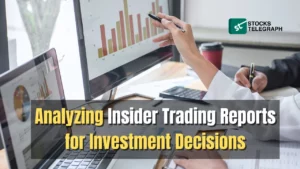Most market participants are well aware of what insider trading is, but have you ever thought deeply about it? Beyond the headlines and legal jargon there is a complex puzzle of key factors that serve as the driving forces behind insider trading activities.
In this article, we delve into these pivotal elements that set the stage for insider trading maneuvers.
From corporate events and financial results to regulatory changes and executive decisions, we’ll uncover the triggers that are prompted when insider trading occurs, and potentially sending ripples through the stock market.
Understanding these factors is not just an academic exercise. It is far more than that. It is a crucial means of protection.
By gaining insights into the motivations behind insider trading, market participants can make more informed decisions, by identify potential risks, and thereby protecting their investments.
Join us as we unravel the web of influences that are active when insider trading occurs.
Legal Definition and Implications
Insider trading isn’t just a moral concern; it’s a legal minefield, so to speak. The U.S. Securities and Exchange Commission (SEC) is the watchdog ensuring fair play in the market, by devising thorough insider trading laws.
So, what’s the technical insider trading definition? Insider trading occurs when you buy or sell securities using nonpublic information, breaking the trust you hold.
In simpler terms, if you’re using information that’s not available to the public yet, and you’re not supposed to have it, you’re abusing your position for financial gain.
Now, the consequences are no joke – hefty fines and maybe some time behind bars. The SEC keeps a hawk eye on these transactions and any other insider trading examples.
Violating insider trading laws doesn’t just mess with individuals; it shakes the very foundation of financial markets. So, stay on the right side of the law because the repercussions are as real as they come.
Factors Causing Insider Trading
We now get to the main part of our investigation: the factors that come into play before Insider trading occurs in the economy. Knowing these key drivers are essential for stock market participants and traders to have awareness about.
-
Earnings Announcements
One of the prime triggers for insider trading is the anticipation and release of earnings announcements. This is around which the bulk of insider trading occurs.
Insiders, such as executives and board members, possess non-public information about the company’s financial performance.
Changes in their trading patterns around the time of earnings releases can be indicative of their expectations or reactions to the upcoming financial results. These insider trading stocks should be closely watched.
-
Mergers and Acquisitions (M&A)
Insider trading tends to surge during periods of mergers, acquisitions, or significant corporate restructuring. Insiders may have access to confidential details about potential deals that can significantly impact a company’s stock value.
Sudden and unusual shifts in insider trading reports ahead of official announcements can signal a potential shift in the company’s strategic direction.
-
Regulatory Developments
Changes in regulations or legal landscapes can prompt insider trading activities.
Insiders may be privy to information about impending regulatory decisions or legal actions that can affect the company’s market position.
This information advantage leads to strategic trading moves by insiders seeking to capitalize on the anticipated impact of regulatory changes.
-
Product Launches and Innovations
If you’re on the lookout for insider trading, pay close attention to significant product launches or innovations within a company.
Insiders may possess insights into the success or challenges associated with new products, services, or technologies. These updates are typically highlighted on insider trading websites.
-
Internal Corporate Developments
Any major internal changes within a company, such as leadership transitions, internal disputes, or unexpected operational challenges, can trigger illegal insider trading.
This is because insiders may adjust their holdings based on their assessment of how these changes will influence the company’s prospects.
Unusual trading patterns among insiders during such times can serve as a noteworthy signal for market participants.
Mitigating Insider Trading Risks
By now, you must be well aware that whenever Insider trading occurs, there is a potential challenge to fair practices of the market.
In order to mitigate these risks, here are discreet strategies designed to prevent and identify such practices within the corporate realm:
-
Confidential Whistleblowing Channels
Establish channels for employees to report concerns regarding potential insider trading, ensuring anonymity.
Anonymized reporting mechanisms empower individuals to disclose information without apprehension, creating a crucial feedback loop for early detection and prevention.
-
Adaptable Insider Trading Guidelines
Develop and regularly revise comprehensive insider trading policy and guidelines. These guidelines should be flexible, adjusting to shifts in regulatory requirements and market dynamics.
Clear communication and periodic reinforcement ensure that stakeholders remain well-versed in the nuances.
-
Behavioral Anomaly Detection Tools
Utilize advanced tools for behavioral analysis to scrutinize trading patterns. These tools can discern anomalies and deviations that may hint at insider trading activities.
By incorporating technology that transcends rule-based monitoring, companies can stay proactive in managing potential risks.
-
Regular Covert Audits
Undertake regular covert audits to assess the efficacy of existing controls and procedures.
Conducted by independent third parties, these audits offer an impartial evaluation of the company’s vulnerabilities, refining preventive measures.
-
External Oversight Engagement
Seek external entities for oversight, tasking them with reviewing processes related to insider trading.
This external perspective provides an additional layer of assurance, pinpointing potential blind spots that might escape internal scrutiny, such as anomalies in insider trading data.
Frequently Asked Questions
Why Does Insider Trading Matter to Traders, And What’s The Key Concern?
Insider trading involves using confidential information for stock trades, impacting market fairness. Traders are concerned as it challenges an even playing field.
What Steps Can Beginners Take to Stay Informed About Insider Trading Regulations?
Stay updated on market regulations, closely follow company news and disclosures, and exercise caution when trading on potentially non-public information. The use of insider trading tracker can also help in this regard.
How Can One Identify Potential Insider Trading Activities?
Unusual trading patterns, sudden stock price movements, and changes in trading volumes might indicate insider activity. Diligent monitoring is key.
How Do Insider Trading Regulations Differ Globally, And Why Does It Matter to Traders Worldwide?
Regulations vary, but most developed markets have strict rules. Global consistency matters as it ensures a level playing field for all market participants.
Should Beginners Rely Solely on Monitoring Insider Trading Activities for Investment Decisions?
While useful, insider trading data should be part of a comprehensive analysis. Beginners should consider other factors like financial health, industry trends, and market conditions.
Can I, As A Regular Investor, Do Anything About Insider Trading?
Report suspicious activity to regulators! Your vigilance can help keep the market fair.












